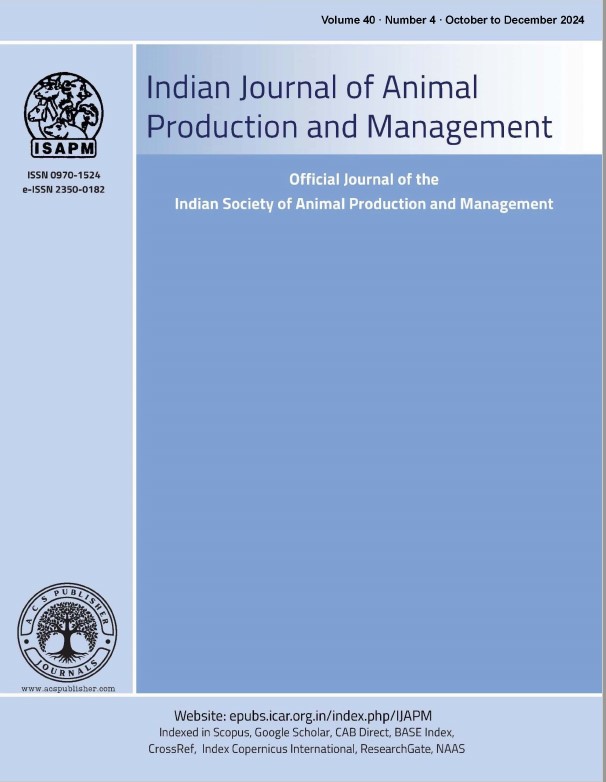Effect of Nutrients and Herbal Products on Immune Status of Broilers, Experimentally Infected with Mixed Eimeria Species
DOI:
https://doi.org/10.48165/ijapm.2023.37.2.10Keywords:
Dietary modulation, Immunological parameters, Poultry coccidiosisAbstract
The present study was conducted to seek herbal alternatives and nutritional modulation to solve the problem of coccidiosis, a deadly protozoan disease of broilers. For the purpose, an experiment of 35 days’ duration (days 0-21 pre-infection period and days 22-35 post-infection period) was conducted to test the efficacy of herbal/natural products/dietary nutrients for the management of mixed coccidial infection prevalent under field conditions. For this purpose wheat grass juice, chelated mineral supplement, herbal anticoccidial and seeds of Embelia ribes without and with sodium bicarbonate, organic chromium, herbal vitamin E-Selenium without and with organic chromium were used to study the immunological parameters of un-infected and infected broilers with 60,000 sporulated oocysts of mixed Eimeria species. Results of the experiment revealed that LST in terms of delta optical density of T- and B-cells was maximum in wheat grass juice while ELISA titre against Newcastle Disease was maximum in herbal vitamin E-Selenium group. All the types of dietary modulation were found to be effective up to different extent in the management of poultry coccidiosis. Further research should focus on micro-array and proteomic technologies to solve the problem.
References
Abebe, E., & Gugsa, G. (2018). A review on poultry coccidiosis. Abyssinia J. Sci. and Tech., 3(1), 1-12.
Blake, D. P., Knox, J., Dehaeck, B., Huntington, B., Rathinam, T., Ravipati, V., & Tomley, F. M. (2020). Re-calculating the cost of coccidiosis in chickens. Veterinary Research, 51, 1-14.
Broom, L. J. (2021). Evidence-based consideration of dietary ‘alternatives’ to anticoccidial drugs to help control poultry coccidial infections. World’s Poult. Sci., 77(1), 43-54.
Chandrashekhar, P. (1994). Studies on immuno-modulatory effect of MDP; Poly 1:C and Interferen gamma in chicks immunized with IBD vaccine. M.V.Sc. Thesis, IVRI, Izatnagar.
Chauhan, R.S. (1995). Text book of Veterinary Clinical and Laboratory Diagnosis. Jay Pee Brothers Medical Publ., New Delhi.
Davies, S.F.M., Joyner, L.P. and Kendall, S.B. (1963). Coccidiosis. 1st ed. Oliver and Boyd Ltd., Edinburg.
Kidd, M.T. (2004). Nutitional modulation immune function in broilers. Poult. Sci.,83 : 650-657.
Kim, W. H., and Lillehoj, H. S. (2019).Immunity, immunomodulation, and antibiotic alternatives to maximize the genetic potential of poultry for growth and disease response. Anim. Feed Sci. and Tech., 250: 41–50. doi:10.1016/j.anifeedsci.2018.09.016.
Klasing, K.C. (1998). Nutritional modulation of resistance to infectious diseases. Poult. Sci., 77 : 1119-1125.
Muthamilselvan, T., Kuo, T. F., Wu, Y. C., & Yang, W. C. (2016). Herbal remedies for coccidiosis control: A review of plants, compounds, and anticoccidial actions. Evidence-based complementary and alternative medicine: eCAM, 2016.
Rai-el-Balhaa, G.; Pellering, J.L.; Bodin, G. and Abdulla, A. (1985). Lymphoblastic transformation assay of sheep peripheral blood lymphocyte: a new rapid and easy to read technique. Comp. Imunol. Microbiol. Infect. Dis., 5 : 387-408.
Singh, V. S., Jyoti, P., Shukla, P. K., and Kumar, R. R. (2009). Influence of turmeric
with alum on growth performance, haematological and parasitological parameters of broilers experimentally infected with mixed Eimeria species. Indian J. Anim.Prod. Manage.,25(3/4):66-69.
Snedecor, G.W. and Cochran, W.G. (1994). Statistical Methods. VIII edn. Iowa University Press, Iowa, U.S.A.
Wakelin, D. and Rose, M.E. (1990) . Immunity to coccidiosis. In: Coccidiosis of Man and Domestic Animals. P.L. Long (Ed.). CRC Press, Boca Raton, FL.

